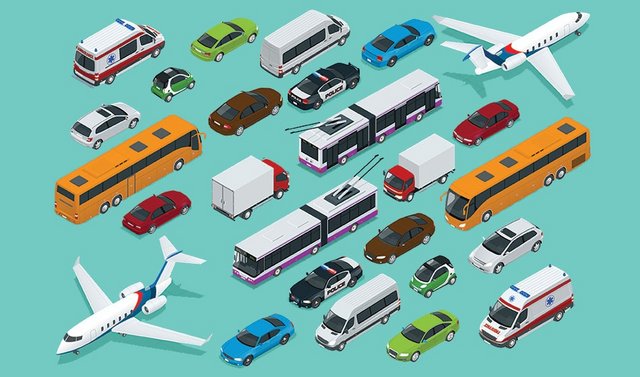Transportation is the movement of people, animals and goods from one location to another. Modes of transport include air, rail, road, water, cable, pipeline and space. The field can be divided into infrastructure, vehicles and operations. Transport is important because it enables trade between people, which is essential for the development of civilizations.

Transport infrastructure consists of the fixed installations including roads, railways, airways, waterways, canals and pipelines and terminals such as airports, railway stations, bus stations, warehouses, trucking terminals, refueling depots (including fueling docks and fuel stations) and seaports. Terminals may be used both for interchange of passengers and cargo and for maintenance.
Forms of Transportation
Road Transport
This is the transport of passengers or goods on roads.
Advantages
- Cheap for shorter distances.
- Quick for shorter distances.
- Door to Door delivery.
- Minimum documents involved.
- It is flexible. Smaller and larger quantities can be transported to most of regions.
- Round the clock availability.
Disadvantages
- Expensive for long distances and heavy loads.
- Slow for long distances.
- Effected by topography.
- Effected by climate.
- Effected by weather conditions.
- Effected by traffic congestions.
- Creates pollution.
- Creates traffic congestions.
Rail Transport
Rail transport is a means of conveyance of passengers and goods on wheeled vehicles running on rails, also known as tracks.
Advantages
- Cheap for long distances.
- Quick for long distances.
- Good to carry bulky cargo.
- Not effected by traffic.
- Does not create pollution in cities.
- Special transporters may be provided for different specialized items.
- Especially suitable for low value and high volume cargo.
Disadvantages
- Involves documentation.
- Need for loading and unloading cargo many times.
- Trains can not go any where.
- Move only according to schedule.
- High costs for short distances and small quantities.
- Located out of cities so depends on road transportation.
- High capital cost of maintenance of tracks and trains.
Air Transportation
A transportation system for moving passengers or goods by air.
Advantages
- Quick.
- Safe handling of cargo.
- Not effected by topography.
- Not much documentation involved.
- Less packing requirement.
- Less insurance cost.
- Especially suitable for high value and low volume cargo.
- Used for urgently required goods.
Disadvantages
- Expensive.
- Effected by weather conditions.
- Has constraints as far as carrying of cargo is concerned.
- Limited space.
Sea Transportation
Main Types of Sea Transport
Ships: “Mother Vessel 40,000 MT- 60,000MT” and “Connecting Vessel 20,000 MT” deep port.
Barge: Small Ship – Shallow port
Ferries: Shallow seas and small distance
Boats: River inland transportation
Main Types of Ships
Passenger liner: Normally used to carrying passengers, mail and some express cargo.
Cargo liner: Mainly used to carry variety of cargo and sometimes few passengers.
Tramp: It is cargo ship which does not sail to any special place. It is normally chartered.
Bulk carrier: It is especially built to carry a particular type of cargo for example oil.
OBO ship: It is can ore-bulk-oil carrier, carries loose material.
Roll-on, roll-off: Highly specialized ships that allows loaded vehicles like trucks, trailers, passenger cars etc.
Advantages
- It is cheap per unit of cargo for longer distances.
- Highly suitable for bulky cargo.
- Refrigerating and other facilities are available.
- Containerization is possible.
- Not effected by topography.
Disadvantages
- Very slow.
- Very rigid.
- It is effected by weather conditions.
- A lot of documentation.
- Lot of handling of cargo is involved.
- Extra cost for insurance and packing.
Containerization
Sending cargo in special metallic box of standard sizes as containers.
Size (i): 20’x8’x8’ known as 20 ft container, suitable for low volume, high weight
Size (ii): 40’x8’x8’ known as 40 ft container, suitable for low weight, high volume
Containers are generally owned by shipping lines.
Refrigerated containers are also available.
Containers are available to the traders on less than container load (LCL) and full container load (FCL) basis.
Less than container: Some of the container;
Full container load: Whole cargo.
Advantages:
- Quick movement of cargo.
- Faster turn-around of ships at ports.
- Protection of cargo from being damaged.
- Saving on packing cost.
- Lesser chances of cargo being lost.
Disadvantages:
- Expensive to own, Capital cost increases.
- Dependence on skilled labor.
Chartering
A vessel/truck/plane is available to the trader on chartered basis by paying a certain amount.
Trader can then cover a certain distance or voyage according to his own schedule.
The agreement signed with the owner is called ‘charted party’.
Chartering is available on voyage and time basis.
Click here to ask a question and get an answer published in the forum. Read our disclaimer.
Get paid for every topic you create in: Shoutam.com Forum!